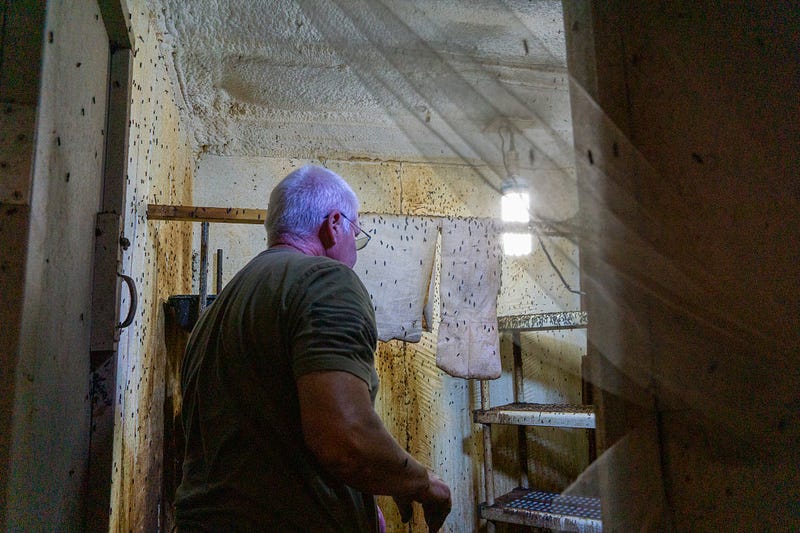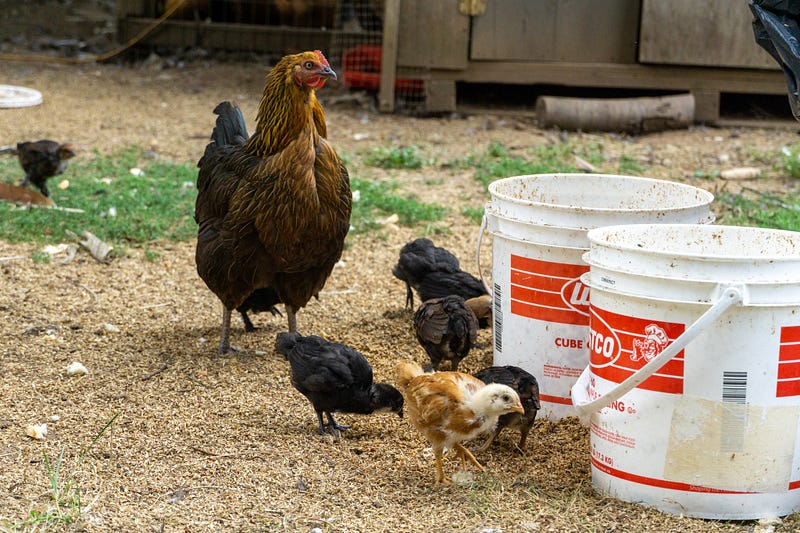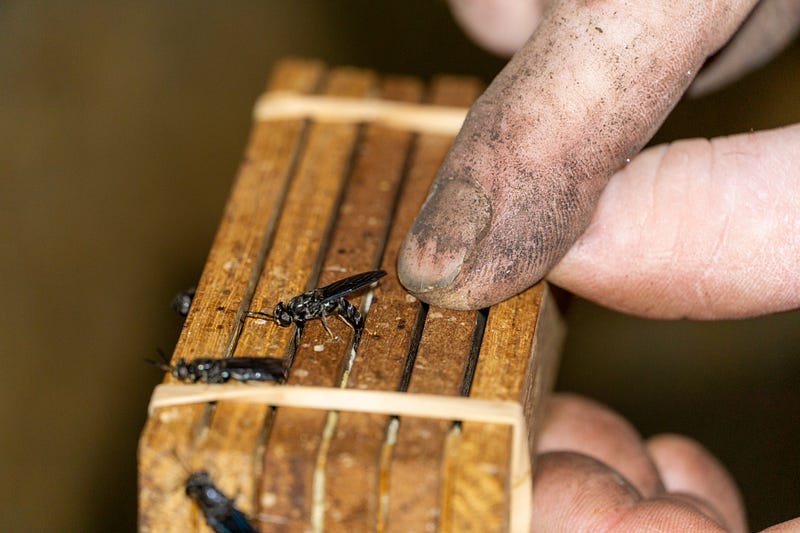Harnessing Insects to Combat Waste and Environmental Challenges
Written on
In a shaded area in Camas, Washington, Doug Knippel’s repurposed semi-trailer exudes a potent aroma reminiscent of sour beer. This scent arises from the hundreds of pounds of leftover barley from a local microbrewery that is being consumed by young Hermetia illucens, or black soldier fly larvae. Dipping his hand into a tray, Knippel reveals a handful of these small, wriggling organisms. “I have been composting since childhood. I enjoy transforming waste into something useful,” he explains. “I’m converting waste into food rather than just compost.”
Knippel represents a growing community of insect breeders who are raising black soldier flies to address three significant environmental challenges in the U.S.: greenhouse gas emissions, unsustainable land use, and food waste. The larvae of these flies transform waste into a sought-after garden fertilizer known as frass, while their later developmental stages are rich in protein and oil, making them an excellent feed for chickens. The black soldier fly industry is projected to reach a value of $2.57 billion by 2030, potentially alleviating the U.S. food waste crisis and its associated greenhouse gas emissions. If global trends are any indicator, these flies might emerge as a significant solution to our waste management problems.

According to the U.S. Department of Agriculture (USDA), approximately 30% to 40% of food produced in America is wasted annually. Much of this food ends up in landfills, contributing to 22% of municipal waste. In landfills, food decomposes without oxygen, releasing methane, a gas that is over 25 times more potent in terms of climate impact than carbon dioxide. Landfills are responsible for nearly a fifth of methane emissions in the U.S.
While composting initiatives have gained traction over the past decade, food waste continues to increase compared to a decade ago. Additionally, American agriculture relies heavily on resource-intensive proteins like soy and fishmeal. The demand for soy leads to significant deforestation in South America, and approximately 20 million tons of edible seafood are diverted each year for use as fishmeal, including for fish species like tilapia that would naturally feed on plant matter.
The black soldier fly offers a sustainable alternative. Adult black soldier flies are slender, dark, and harmless, living for only about a week. Unlike houseflies, they are not drawn to human environments, do not spread diseases, and are found naturally in many regions. A single female can lay around 500 eggs, which hatch into larvae within four days. These larvae consume decomposing matter, from vegetable scraps to meat, devouring twice their body weight daily. After about a week, they reach an optimal state for harvesting, rich in protein and fat.
Knippel utilizes a screening process to separate smaller larvae from waste and larger larvae. While younger larvae are light in color, the mature ones become dark and are either fed to his chickens or harvested to continue the breeding process. Notably, these larvae instinctively seek drier environments, which producers can leverage by placing small ladders in their waste bins to facilitate self-harvesting.
The nutritional value of these larvae is noteworthy. A hectare of land can yield about one ton of soy annually, which depletes and degrades soil. In contrast, the same area could potentially yield up to 150 tons of insect protein, continually replenished with organic waste. A 2019 study published in Waste Management found that black soldier flies can reduce carbon dioxide emissions to nearly half of what is generated through composting, which itself is already a preferable method compared to landfilling.
Historically, black soldier fly larvae have been a popular food source for reptiles, but regulatory changes in 2017 by the Association of American Feed Control Officials now allow their use as feed for chickens and certain fish. Chickens consume the larvae whole, a practice that Knippel employs in his operations. Larger companies like Enviroflight, on the other hand, extract oil from the larvae and process the remaining protein for wholesale distribution, allowing for precise nutrient formulation for animal feed.

Like Knippel, many in the soldier fly industry aim to convert waste into valuable resources. Currently, most companies focus on pre-consumer waste, using materials like grains from distilleries or leftover barley. However, the full potential of kitchen waste remains largely untapped.
There’s a preference for pre-consumer waste due to variable nutrient content in larvae depending on their diet, and concerns about contamination in post-consumer waste. As a result, many countries restrict black soldier flies to pre-consumer waste only.
Some are pushing the boundaries by using post-consumer food waste. For example, Devon Brits, a research assistant at Louisiana State University, collects food scraps from campus dining halls and transports them to an insect farm. There, the scraps are processed into a slurry fed to the larvae. “It smells almost fruity,” Brits describes. This initiative processes about two tons of cafeteria waste weekly, in collaboration with reptile food producers.
Brits, who has experience with black soldier flies from South Africa, reports no significant differences in the larvae’s quality when fed post-consumer waste, thanks in part to the consistency of cafeteria food. Nonetheless, weekly testing for pathogens such as salmonella and E. coli is conducted. Some larvae are sold, while others are returned to the farm for breeding.
Scaling such a system to a municipal level remains a challenge. Several international firms like AgriProtein in South Africa are turning waste into protein, with legislation permitting the use of post-consumer waste. They are also piloting a facility in California focused on pre-consumer waste. Enterra, one of the largest companies in the industry, has established a large plant near Calgary, Canada, while countries like France, Chile, and the Netherlands have operational black soldier fly enterprises primarily focused on protein production.
The breeding process is the most demanding and costly aspect of the operation. Knippel’s trailer, originally designed by a supplier who struggled with breeding success, highlights this challenge. The delicate nature of flies regarding temperature, humidity, and pressure can significantly impact reproduction rates. After a year and a half of trials, the previous supplier handed the project over to Knippel, who then successfully created an optimal breeding environment, leading to successful egg-laying within two weeks.

The economics of raising larvae present their own challenges. Spring Yang, founder of a larvae company in Texas, emphasizes that for the industry to be profitable, larvae must be marketed as a protein source rather than merely a waste processing solution. He advocates for a division within the industry into three sectors: fly breeders, waste processors, and feed manufacturers, each supporting the others.
However, innovative waste-diversion projects are emerging. Charlotte, North Carolina, is planning a pilot initiative to redirect post-consumer waste from landfills to support local farmers. In Guangzhou, China, a facility can handle up to 50 tons of food waste daily. Even within the U.S., which is often limited to pre-consumer waste, there remains a substantial supply for the larvae.
Moreover, impactful initiatives do not have to be large-scale. Numerous university studies are exploring the larvae's appetite across the country. In Texas, one company utilizes flies to process restaurant leftovers, while farmers are developing closed-loop systems to breed larvae for poultry feed.
Knippel’s 10-acre farm receives 10,000 pounds of food waste weekly from food banks and vendors. Although his red wigglers effectively convert produce into valuable compost, he believes black soldier flies are even more efficient. While worms can take months to produce their castings, Knippel’s larvae can rapidly process up to 100 pounds of barley in a single day, with the potential to handle ten times that amount.
His vision includes expanding from a single breeding room to a larger facility, estimated to cost $200,000, which could significantly increase his production. With such an expansion, he believes he could manage all the waste for his community of nearly 24,000 residents.
“I just love the fact they can consume so much so fast,” Knippel states. “While I appreciate the worms, I invest more effort in them than I do with the larvae, yet the larvae yield much more in return.”